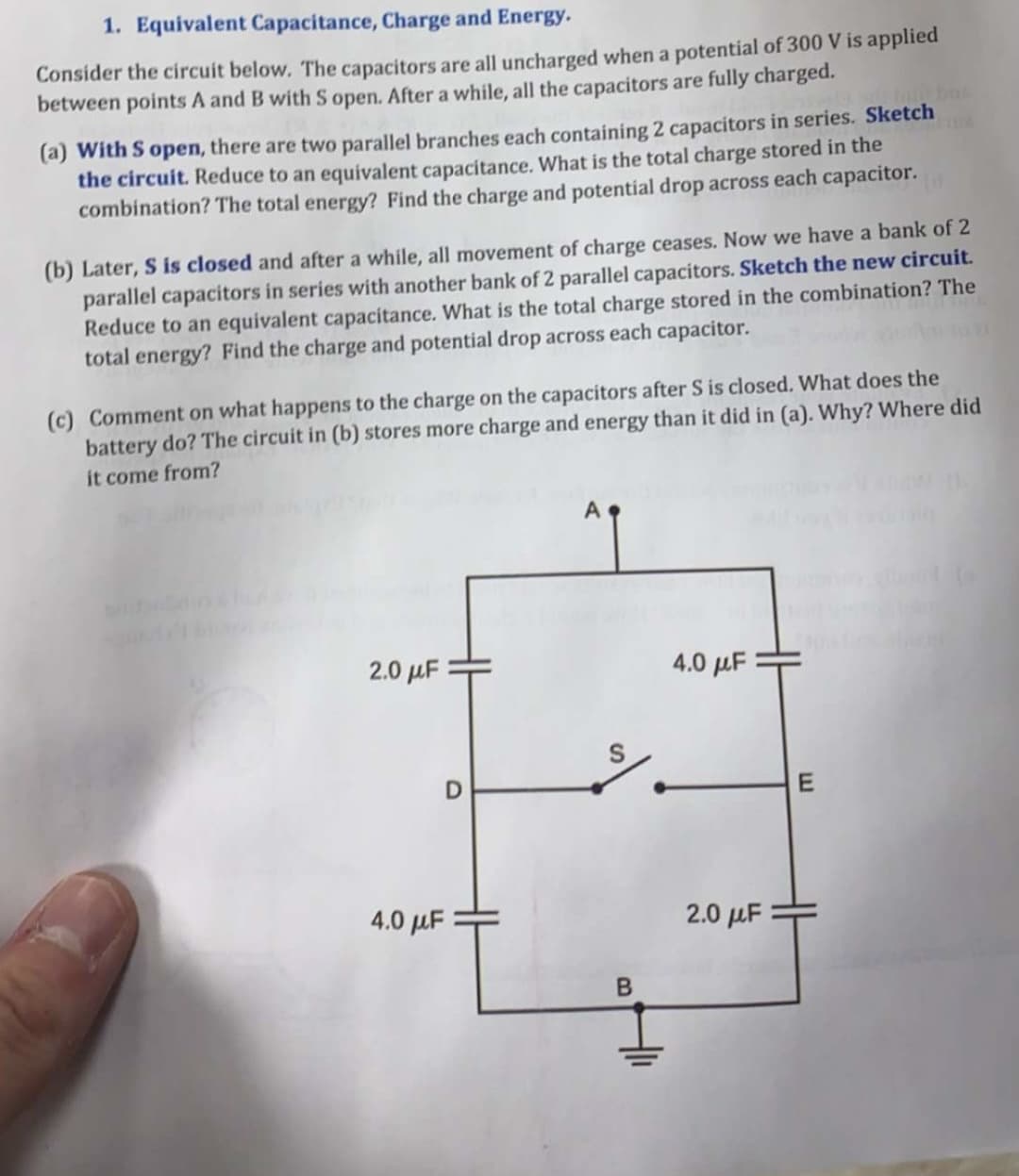1. Equivalent Capacitance, Charge and Energy. Consider the circuit below. The capacitors are all uncharged when a potential of 300 V is applied between points A and B with S open. After a while, all the capacitors are fully charged. (a) With S open, there are two parallel branches each containing 2 capacitors in series. Sketch the circuit. Reduce to an equivalent capacitance. What is the total charge stored in the combination? The total energy? Find the charge and potential drop across each capacitor. (b) Later, S is closed and after a while, all movement of charge ceases. Now we have a bank of 2 parallel capacitors in series with another bank of 2 parallel capacitors. Sketch the new circuit. Reduce to an equivalent capacítance. What is the total charge stored in the combination? The total energy? Find the charge and potential drop across each capacitor. (c) Comment on what happens to the charge on the capacitors after S is closed. What does the battery do? The circuit in (b) stores more charge and energy than it did in (a). Why? Where did it come from? A 2.0 µF 4.0 µF 4.0 µF 2.0 µF
1. Equivalent Capacitance, Charge and Energy. Consider the circuit below. The capacitors are all uncharged when a potential of 300 V is applied between points A and B with S open. After a while, all the capacitors are fully charged. (a) With S open, there are two parallel branches each containing 2 capacitors in series. Sketch the circuit. Reduce to an equivalent capacitance. What is the total charge stored in the combination? The total energy? Find the charge and potential drop across each capacitor. (b) Later, S is closed and after a while, all movement of charge ceases. Now we have a bank of 2 parallel capacitors in series with another bank of 2 parallel capacitors. Sketch the new circuit. Reduce to an equivalent capacítance. What is the total charge stored in the combination? The total energy? Find the charge and potential drop across each capacitor. (c) Comment on what happens to the charge on the capacitors after S is closed. What does the battery do? The circuit in (b) stores more charge and energy than it did in (a). Why? Where did it come from? A 2.0 µF 4.0 µF 4.0 µF 2.0 µF
Delmar's Standard Textbook Of Electricity
7th Edition
ISBN:9781337900348
Author:Stephen L. Herman
Publisher:Stephen L. Herman
Chapter20: Capacitance In Ac Circuits
Section: Chapter Questions
Problem 5PP: Three capacitors having capacitance values of 20F,40F, and 50F are connected in parallel to a 60 -...
Related questions
Question
I don't understand how to do this

Transcribed Image Text:1. Equivalent Capacitance, Charge and Energy.
Consider the circuit below. The capacitors are all uncharged when a potential of 300 V is applied
between points A and B with S open. After a while, all the capacitors are fully charged.
(a) With S open, there are two parallel branches each containing 2 capacitors in series. Sketch
the circuit. Reduce to an equivalent capacitance. What is the total charge stored in the
combination? The total energy? Find the charge and potential drop across each capacitor.
(b) Later, S is closed and after a while, all movement of charge ceases. Now we have a bank of 2
parallel capacitors in series with another bank of 2 parallel capacitors. Sketch the new circuit.
Reduce to an equivalent capacitance. What is the total charge stored in the combination? The
total energy? Find the charge and potential drop across each capacitor.
(c) Comment on what happens to the charge on the capacitors after S is closed. What does the
battery do? The circuit in (b) stores more charge and energy than it did in (a). Why? Where did
it come from?
A
2.0 μF
4.0 µF
4.0 µF
2.0 µF
B
Expert Solution
This question has been solved!
Explore an expertly crafted, step-by-step solution for a thorough understanding of key concepts.
This is a popular solution!
Trending now
This is a popular solution!
Step by step
Solved in 6 steps with 6 images

Knowledge Booster
Learn more about
Need a deep-dive on the concept behind this application? Look no further. Learn more about this topic, electrical-engineering and related others by exploring similar questions and additional content below.Recommended textbooks for you

Delmar's Standard Textbook Of Electricity
Electrical Engineering
ISBN:
9781337900348
Author:
Stephen L. Herman
Publisher:
Cengage Learning

Delmar's Standard Textbook Of Electricity
Electrical Engineering
ISBN:
9781337900348
Author:
Stephen L. Herman
Publisher:
Cengage Learning